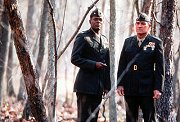Rules of Engagement
 for scenes of war violence, and for language.
for scenes of war violence, and for language.
Reviewed by: Debbie James
CONTRIBUTOR
| Moral Rating: | Very Offensive |
| Moviemaking Quality: |
|
| Primary Audience: | Mature Teen to Adult |
| Genre: | Drama |
| Length: | 2 hr. 3 min. |
| Year of Release: | 2000 |
| USA Release: |

| Featuring | Tommy Lee Jones, Samuel L. Jackson, Ben Kingsley, Blair Underwood, Anne Archer, Bruce Greenwood |
| Director |
William Friedkin |
| Producer | Scott Rudin, Richard D. Zanuck |
| Distributor |
 Paramount Pictures Corporation, a subsidiary of ViacomCBS |
“Rules of Engagement” begins with scenes of the Vietnam War, where buddies Hayes Hodges (Tommy Lee Jones) and Terry Childers (Samuel L. Jackson) are each commanding a team of Marines. When Hodges’ men are pinned down by intense enemy gunfire, and Hodges is wounded, Childers comes to his assistance and saves his life.
We are then advanced 28 years ahead as we witness Hodges’ retirement party where he is awarded a prized Marine sword by his old buddy, Childers. Afterwards the two men discuss the paths their lives took after the war; Hodges to a job as a military lawyer because of his war injuries, and Childers, a highly decorated and respected combat veteran who’s about to go an another mission.

While onboard the U.S.S. Wake, stationed in the Indian Ocean, Childers receives his orders. There is civil unrest at the U.S. Embassy in Yemen, and the Marines are to go and assess the situation and evacuate Ambassador Mourain (Ben Kingsley) and his family, if necessary.
Upon arrival, they discover the situation is boiling over, with an angry crowd hurling rocks and Molotov cocktails at the Embassy building. During the evacuation process, they come under heavy gunfire from snipers positioned on rooftops and throughout the crowd. When three of Childers’ men are killed, he reacts by ordering his men to fire into the crowd, killing the snipers, as well as many women and children who were present in the crowd.
When National Security Adviser William Sokal (Bruce Greenwood) hears what’s happened, he decides that for the U.S. to claim responsibility would be a bad move politically, so he has Childers court-martialed on charges of violating the rules of engagement by firing on a crowd of civilians.
Childers hires newly-retired Hodges as his attorney and they begin the battle to clear his name. Unfortunately, a certain piece of evidence turns up “missing,” and the trial is set for just two weeks, which doesn’t give Hodges much time. When Hodges travels to Yemen to investigate, he strangely misses a major, obvious piece of evidence that would prove his client’s claims of what happenend that day. Despite that plothole, “Rules of Engagement” is still engaging to watch.
Objectionable material present include the obvious, and extremely bloody, Vietnam and Yemen battle scenes. There are approximately two dozen uses of the “f” word and an almost equal number of the Lord’s name misused. There is no sex or nudity.

